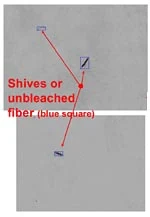A shive or sliver is a small bundle of fibers that were not properly broken down by the chemical pulping process when making paper. Both looks similar, but the cause is slightly different.
Shive - This describes a small piece of wood in the paper making process that has been cooked, but the fibers did not break down and separate properly. Most shives are separated in the screening process but not all. They are difficult to identify because they have been bleached in the chemical process.
Sliver - This describes small splinters of wood will not get cooked properly and make their way into the sheet. It is easily seen in the paper and is a long fibrous defect that is more easily seen.
Both slivers and shives causes web breaks for web offset printers. Each of these defects cause a weakness, or even a slight cut in the paper. When put under tension, these will cause breaks. Especially when the defect is at the edge of the paper.
What shives they look like
While the above picture shows how a sliver and shive can differ in shape, shives are more difficult to spot as they take lose their color in the bleaching process.
 |
| A shive is barely discernible but can cause breaks in the web. |
This paper defect comes from the paper mill. While most will run through an offset printing press without problems, web breaks or excessive discoloration of the sheet should be reported.


Comments
Post a Comment